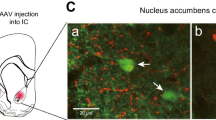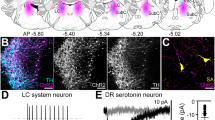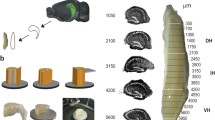Abstract
The mammalian neocortex is a multilayered structure receiving extensive adrenergic projections both in rostral and caudal areas. The cellular mechanisms of norepinephrine (NE) in the neocortex are incompletely understood. We used electrophysiology to determine whether NE modulation of synaptic transmission were similar in rostral versus caudal cortical areas, and in infra- versus supra-granular cortical layers. To address these questions we used bath applications of NE (20 µM) to determine its effects on pharmacologically isolated electrically-evoked 2-amino-3-(3-hydroxy-5-methyl-isoxazol-4-yl) propionic acid receptor (AMPAR)-mediated excitatory synaptic currents (eEPSCs), or γ-amino butyric acid A receptor (GABAAR)-mediated inhibitory synaptic currents (eIPSCs). We monitored synaptic currents in pyramidal neurons using whole-cell patch-clamp recordings from supragranular layer 2/3 (L2/3) and infragranular layer 5 (L5) neurons in a thin-slice preparation of rat medial prefrontal cortex (mPFC). These results were compared with the effects in the temporal cortex (TC) under similar experimental conditions. We found that NE uniformly and transiently depressed eEPSCs from supragranular to infragranular layers in both the PFC and the TC. On the contrary, the effects of NE on eIPSC were area- and layer-dependent, as NE enhanced the mean amplitude in TC L2/3 and PFC L5 eIPSCs (which displayed the largest saturation currents in the areas studied) but depressed PFC L2/3 eIPSCs, without affecting TC L5 eIPSCs. While the precise physiological meaning of these results is still unclear, our data are consistent with the existence of a dense noradrenergic-controlled GABAergic cortical network in the PFC, in which L5 may act as a decisional bottleneck for behavioral inhibition.




Similar content being viewed by others
References
Aston-Jones G, Cohen JD (2005) Adaptive gain and the role of the locus coeruleus-norepinephrine system in optimal performance. J Comp Neurol 493(1):99–110. doi:10.1002/cne.20723
Nieuwenhuis S, Aston-Jones G, Cohen JD (2005) Decision making, the P3, and the locus coeruleus-norepinephrine system. Psychol Bull 131(4):510–532. doi:10.1037/0033-2909.131.4.510
Dalley JW, Cardinal RN, Robbins TW (2004) Prefrontal executive and cognitive functions in rodents: neural and neurochemical substrates. Neurosci Biobehav Rev 28(7):771–784. doi:10.1016/j.neubiorev.2004.09.006
Foehring RC, Schwindt PC, Crill WE (1989) Norepinephrine selectively reduces slow Ca2+- and Na+-mediated K+ currents in cat neocortical neurons. J Neurophysiol 61(2):245–256
Kobayashi T, Washiyama K, Ikeda K (2010) Inhibition of G-protein-activated inwardly rectifying K+ channels by the selective norepinephrine reuptake inhibitors atomoxetine and reboxetine. Neuropsychopharmacology 35(7):1560–1569. doi:10.1038/npp.2010.27
Vertes RP (2006) Interactions among the medial prefrontal cortex, hippocampus and midline thalamus in emotional and cognitive processing in the rat. Neuroscience 142(1):1–20. doi:10.1016/j.neuroscience.2006.06.027
Euston DR, Gruber AJ, McNaughton BL (2012) The role of medial prefrontal cortex in memory and decision making. Neuron 76(6):1057–1070. doi:10.1016/j.neuron.2012.12.002
Hoover WB, Vertes RP (2011) Projections of the medial orbital and ventral orbital cortex in the rat. J Comp Neurol 519(18):3766–3801. doi:10.1002/cne.22733
Little JP, Carter AG (2012) Subcellular synaptic connectivity of layer 2 pyramidal neurons in the medial prefrontal cortex. J Neurosci 32(37):12808–12819. doi:10.1523/JNEUROSCI.1616-12.2012
Florin-Lechner SM, Druhan JP, Aston-Jones G, Valentino RJ (1996) Enhanced norepinephrine release in prefrontal cortex with burst stimulation of the locus coeruleus. Brain Res 742(1–2):89–97
Devoto P, Flore G, Saba P, Fa M, Gessa GL (2005) Stimulation of the locus coeruleus elicits noradrenaline and dopamine release in the medial prefrontal and parietal cortex. J Neurochem 92(2):368–374. doi:10.1111/j.1471-4159.2004.02866.x
Mantz J, Milla C, Glowinski J, Thierry AM (1988) Differential effects of ascending neurons containing dopamine and noradrenaline in the control of spontaneous activity and of evoked responses in the rat prefrontal cortex. Neuroscience 27(2):517–526
Wang Y, Zhang QJ, Liu J, Ali U, Gui ZH, Hui YP, Wang T, Chen L, Li Q (2010) Noradrenergic lesion of the locus coeruleus increases the firing activity of the medial prefrontal cortex pyramidal neurons and the role of alpha2-adrenoceptors in normal and medial forebrain bundle lesioned rats. Brain Res 1324:64–74. doi:10.1016/j.brainres.2010.02.009
Aston-Jones G (1985) Behavioral functions of locus coeruleus derived from cellular attributes. Physiol Psychol 13:118–126
Aston-Jones G, Cohen JD (2005) An integrative theory of locus coeruleus-norepinephrine function: adaptive gain and optimal performance. Annu Rev Neurosci 28:403–450. doi:10.1146/annurev.neuro.28.061604.135709
Otis JM, Dashew KB, Mueller D (2013) Neurobiological dissociation of retrieval and reconsolidation of cocaine-associated memory. J Neurosci 33(3):1271–1281a. doi:10.1523/JNEUROSCI.3463-12.2013
Oswald AM, Schiff ML, Reyes AD (2006) Synaptic mechanisms underlying auditory processing. Curr Opin Neurobiol 16(4):371–376. doi:10.1016/j.conb.2006.06.015
Edeline JM (2012) Beyond traditional approaches to understanding the functional role of neuromodulators in sensory cortices. Front Behav Neurosci 6:45. doi:10.3389/fnbeh.2012.00045
Manunta Y, Edeline JM (1997) Effects of noradrenaline on frequency tuning of rat auditory cortex neurons. Eur J Neurosci 9(4):833–847
Manunta Y, Edeline JM (1998) Effects of noradrenaline on rate-level function of auditory cortex neurons: is there a “gating” effect of noradrenaline? Exp Brain Res 118(3):361–372
Manunta Y, Edeline JM (1999) Effects of noradrenaline on frequency tuning of auditory cortex neurons during wakefulness and slow-wave sleep. Eur J Neurosci 11(6):2134–2150
Manunta Y, Edeline JM (2004) Noradrenergic induction of selective plasticity in the frequency tuning of auditory cortex neurons. J Neurophysiol 92(3):1445–1463
Atzori M, Kanold PO, Pineda JC, Flores-Hernandez J, Paz RD (2005) Dopamine prevents muscarinic-induced decrease of glutamate release in the auditory cortex. Neuroscience 134(4):1153–1165
Dinh L, Nguyen T, Salgado H, Atzori M (2009) Norepinephrine Homogeneously Inhibits alpha-amino-3-hydroxyl-5-methyl-4-isoxazole-propionate- (AMPAR-) mediated currents in all layers of the temporal cortex of the rat. Neurochem Res 34(11):1896–1906. doi:10.1007/s11064-009-9966-z
Salgado H, Garcia-Oscos F, Patel A, Martinolich L, Nichols JA, Dinh L, Roychowdhury S, Tseng KY, Atzori M (2011) Layer-specific noradrenergic modulation of inhibition in cortical layer II/III. Cereb Cortex 21(1):212–221. doi:10.1093/cercor/bhq081
Kim J, Alger BE (2001) Random response fluctuations lead to spurious paired-pulse facilitation. J Neurosci 21(24):9608–9618
Kobayashi M, Imamura K, Sugai T, Onoda N, Yamamoto M, Komai S, Watanabe Y (2000) Selective suppression of horizontal propagation in rat visual cortex by norepinephrine. Eur J Neurosci 12(1):264–272
Dodt HU, Pawelzik H, Zieglgansberger W (1991) Actions of noradrenaline on neocortical neurons in vitro. Brain Res 545(1–2):307–311
Hasselmo ME, Linster C, Patil M, Ma D, Cekic M (1997) Noradrenergic suppression of synaptic transmission may influence cortical signal-to-noise ratio. J Neurophysiol 77(6):3326–3339
Law-Tho D, Crepel F, Hirsch JC (1993) Noradrenaline decreases transmission of NMDA- and non-NMDA-receptor mediated monosynaptic EPSPs in rat prefrontal neurons in vitro. Eur J Neurosci 5(11):1494–1500
Lorenzon NM, Foehring RC (1992) Relationship between repetitive firing and afterhyperpolarizations in human neocortical neurons. J Neurophysiol 67(2):350–363
Pedarzani P, Storm JF (1995) Dopamine modulates the slow Ca(2+)-activated K+ current IAHP via cyclic AMP-dependent protein kinase in hippocampal neurons. J Neurophysiol 74(6):2749–2753
Krnjevic K (1993) Central cholinergic mechanisms and function. Prog Brain Res 98:285–292
Thomases DR, Cass DK, Tseng KY (2013) Periadolescent exposure to the NMDA receptor antagonist MK-801 impairs the functional maturation of local GABAergic circuits in the adult prefrontal cortex. J Neurosci 33(1):26–34. doi:10.1523/JNEUROSCI.4147-12.2013
Bartolini G, Ciceri G, Marin O (2013) Integration of GABAergic interneurons into cortical cell assemblies: lessons from embryos and adults. Neuron 79(5):849–864. doi:10.1016/j.neuron.2013.08.014
DeFelipe J, Lopez-Cruz PL, Benavides-Piccione R, Bielza C, Larranaga P, Anderson S, Burkhalter A, Cauli B, Fairen A, Feldmeyer D, Fishell G, Fitzpatrick D, Freund TF, Gonzalez-Burgos G, Hestrin S, Hill S, Hof PR, Huang J, Jones EG, Kawaguchi Y, Kisvarday Z, Kubota Y, Lewis DA, Marin O, Markram H, McBain CJ, Meyer HS, Monyer H, Nelson SB, Rockland K, Rossier J, Rubenstein JL, Rudy B, Scanziani M, Shepherd GM, Sherwood CC, Staiger JF, Tamas G, Thomson A, Wang Y, Yuste R, Ascoli GA (2013) New insights into the classification and nomenclature of cortical GABAergic interneurons. Nat Rev Neurosci 14(3):202–216. doi:10.1038/nrn3444
Ascoli GA, Alonso-Nanclares L, Anderson SA, Barrionuevo G, Benavides-Piccione R, Burkhalter A, Buzsaki G, Cauli B, Defelipe J, Fairen A, Feldmeyer D, Fishell G, Fregnac Y, Freund TF, Gardner D, Gardner EP, Goldberg JH, Helmstaedter M, Hestrin S, Karube F, Kisvarday ZF, Lambolez B, Lewis DA, Marin O, Markram H, Munoz A, Packer A, Petersen CC, Rockland KS, Rossier J, Rudy B, Somogyi P, Staiger JF, Tamas G, Thomson AM, Toledo-Rodriguez M, Wang Y, West DC, Yuste R (2008) Petilla terminology: nomenclature of features of GABAergic interneurons of the cerebral cortex. Nat Rev Neurosci 9(7):557–568
Markram H, Toledo-Rodriguez M, Wang Y, Gupta A, Silberberg G, Wu C (2004) Interneurons of the neocortical inhibitory system. Nat Rev Neurosci 5(10):793–807
Papoutsi A, Sidiropoulou K, Cutsuridis V, Poirazi P (2013) Induction and modulation of persistent activity in a layer V PFC microcircuit model. Front Neural Circuits 7:161. doi:10.3389/fncir.2013.00161
Haggerty DC, Glykos V, Adams NE, Lebeau FE (2013) Bidirectional modulation of hippocampal gamma (20–80 Hz) frequency activity in vitro via alpha(alpha)- and beta(beta)-adrenergic receptors (AR). Neuroscience 253:142–154. doi:10.1016/j.neuroscience.2013.08.028
Schulz SB, Heidmann KE, Mike A, Klaft ZJ, Heinemann U, Gerevich Z (2012) First and second generation antipsychotics influence hippocampal gamma oscillations by interactions with 5-HT3 and D3 receptors. Br J Pharmacol 167(7):1480–1491. doi:10.1111/j.1476-5381.2012.02107.x
Gulyas AI, Szabo GG, Ulbert I, Holderith N, Monyer H, Erdelyi F, Szabo G, Freund TF, Hajos N (2010) Parvalbumin-containing fast-spiking basket cells generate the field potential oscillations induced by cholinergic receptor activation in the hippocampus. J Neurosci 30(45):15134–15145. doi:10.1523/JNEUROSCI.4104-10.2010
Fineberg NA, Potenza MN, Chamberlain SR, Berlin HA, Menzies L, Bechara A, Sahakian BJ, Robbins TW, Bullmore ET, Hollander E (2010) Probing compulsive and impulsive behaviors, from animal models to endophenotypes: a narrative review. Neuropsychopharmacology 35(3):591–604. doi:10.1038/npp.2009.185
Bari A, Robbins TW (2013) Inhibition and impulsivity: behavioral and neural basis of response control. Prog Neurobiol 108:44–79. doi:10.1016/j.pneurobio.2013.06.005
Bari A, Robbins TW (2013) Noradrenergic versus dopaminergic modulation of impulsivity, attention and monitoring behaviour in rats performing the stop-signal task: possible relevance to ADHD. Psychopharmacology 230(1):89–111. doi:10.1007/s00213-013-3141-6
Acknowledgements
The work was funded with a PROMEP/PRODEP and a Basic Science/CONACyT grant to MA.
Author information
Authors and Affiliations
Corresponding author
Rights and permissions
About this article
Cite this article
Roychowdhury, S., Zwierzchowski, A.N., Garcia-Oscos, F. et al. Layer- and Area-Specificity of the Adrenergic Modulation of Synaptic Transmission in the Rat Neocortex. Neurochem Res 39, 2377–2384 (2014). https://doi.org/10.1007/s11064-014-1440-x
Received:
Revised:
Accepted:
Published:
Issue Date:
DOI: https://doi.org/10.1007/s11064-014-1440-x




